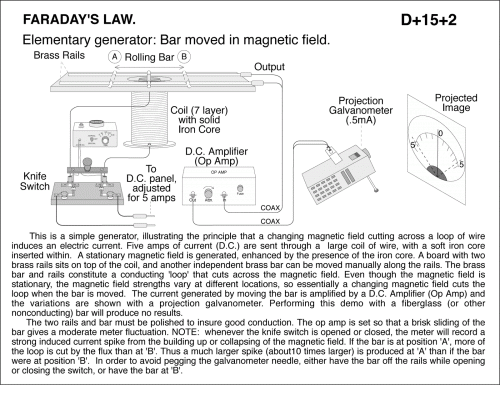Elementary generator: Bar moved in magnetic field.
Primary tabs
Elementary generator: Bar moved in magnetic field. This is a simple generator, illustrating the principle that a changing magnetic field cutting across a loop of wire induces an electric current. Five amps of current (D.C.) are sent through a large coil of wire, with a soft iron core inserted within. A stationary magnetic field is generated, enhanced by the presence of the iron core. A board with two brass rails sits on top of the coil, and another independent brass bar can be moved manually along the rails. The brass bar and rails constitute a conducting 'loop' that cuts across the magnetic field. Even though the magnetic field is stationary, the magnetic field strengths vary at different locations, so essentially a changing magnetic field cuts the loop when the bar is moved. The current generated by moving the bar is amplified by a D.C. Amplifier (Op Amp) and the variations are shown with a projection galvanometer. Performing this demo with a fiberglass (or other nonconducting) bar will produce no results. The two rails and bar must be polished to insure good conduction. The op amp is set so that a brisk sliding of the bar gives a moderate meter fluctuation. NOTE: whenever the knife switch is opened or closed, the meter will record a strong induced current spike from the building up or collapsing of the magnetic field. If the bar is at position 'A', more of the loop is cut by the flux than at 'B'. Thus a much larger spike (about10 times larger) is produced at 'A' than if the bar were at position 'B'. In order to avoid pegging the galvanometer needle, either have the bar off the rails while opening or closing the switch, or have the bar at 'B'.
UCB Index:
D+15+2
PIRA Index:
5K10.10
Demo Picture:
UCB Taxonomy:
PIRA Taxonomy:
Video:
Popularity:
- Log in to post comments

